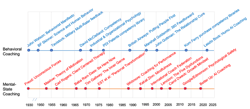Behavior-Based vs. Mental-State: Which Coaching Approach Is the Best Fit?
Executive coaching has evolved along two very different paths. One focuses on external behavior; the other centers on the internal world. These two traditions come from very different worldviews. Both are valid. So, which one’s right?
Instead of arguing definitions, it's more useful to recognize the two approaches for what they are:
- Behavior-based coaching: rooted in behaviorism, focused on shaping observable actions; assess, instruct, reward.
- Mental-state coaching: grounded in humanistic psychology, focused on raising awareness and self-actualization through reflection and trust.
This divide traces back over the last 100 years and is represented by the views of the two most influential psychologists of that period —B.F. Skinner versus Carl Rogers.
Rogers’ approach is well captured in his own words: "If I can provide a certain type of relationship, the other person will discover within himself the capacity to use that relationship for growth and change, and personal development will occur.”—"On Becoming A Person,” 1962
The dramatically different views of Skinner are that all behavior is shaped by environmental contingencies—rewards and punishments—and our good nature should not be assumed. "We cannot afford freedom, and so it must be replaced with control over man, his conduct, and his culture.” —“Beyond Freedom and Dignity,” 1971
Their legacies continue to shape how we practice coaching today, and it is helpful to see how these ideas have evolved over time.
The Evolution of Two Coaching Traditions
With this background in mind, let us consider a few typical executive coaching scenarios and then reflect on how each approach can be beneficial.
1. Becoming a Leader
Dana leads a small IT team for a financial services firm. She’s exceptional—so good, in fact, that she’s become the go-to person for every urgent issue. But this has a cost: she’s burned out, her weekends are gone, and her family life is suffering.
Her personal goal is to escape this unsustainable grind and become a stronger, more inspiring leader. Her company wants the same outcomes—scalability, higher standards, and a more capable team—but they're hesitant to invest in more staff. It's a classic mid-level management trap.
To move forward, Dana needs support on two levels. Internally, she must reimagine herself—not as a people-pleasing fixer, but as a peer among leaders with permission to advocate and act. This shift in mindset requires a coach skilled in mental-state work: someone who can help her unearth self-limiting beliefs and find the courage to lead differently.
On the behavioral side, she’ll need to create and sell a vision, build team capacity and change how she allocates her time. She will have to push for new hires, implement best practices and establish new norms. A coach with behavioral expertise will help her prioritize winning behaviors and stay accountable.
Dana doesn’t just need inspiration or tactics—she needs both.
2. Getting to the Top
Peter, head of product and strategy, is a standout performer and the intellectual engine of his team. Yet despite his ambition to become CEO, he’s not viewed as a candidate. He’s new to the team, quiet in meetings and still perceived as a protégé of a former leader.
He also travels constantly, trying to be a present dad when he's home—but often running on empty. He’s made peace with the tradeoff: working hard now to build long-term stability for his family. Still, the gap between what he wants and how he’s seen is growing.
Peter doesn’t need motivation—he needs visibility, presence and influence. His coach must create a safe and confidential space for candid conversations about style, perception and impact. He needs more than tactical advice—he needs a thought partner who can help him reflect on how he shows up, and how others experience him.
While Peter has long relied on intellect and drive, that alone won’t carry him further. He needs to build trust among his peers and show up as a leader others want to follow. This means adjusting his communication—not to be someone else, but to connect more fully and visibly with those around him.
A targeted, interview-based 360 feedback process—designed with Peter’s goals in mind—can help him gain crucial insight into how he’s perceived. But it must be done right: delivered in a way that protects his agency, not flattens him with judgment. Designing that feedback, translating it into actions, and keeping those changes on track will be the behavioral coaching layer.
When behavioral tools are used with empathy and tied to the client’s own aspirations, they become part of a truly integrated coaching method—one that supports the leader by providing a safe space for reflection and rewarding helpful behavioral change at the same time.
3. The Executive Team
“Chris, I’d like you to coach my team—not the usual leadership stuff, but help us to align around an ambitious new strategy and execute with fresh energy and collaboration.”
That was the invitation from a former client—and it captures what many senior teams truly want: not another offsite, but a transformation.
The perfectly clicking, high-performing team united behind a bold mission is a rare thing. Most teams fall short because of one or more predictable challenges:
Stagnation – The world is evolving fast, but the team isn’t keeping up.
Fragmentation – Members identify more with their functions than with the team
Disruptive personalities – Behaviors drain motivation or stall progress.
Gaps in capability – Not everyone is equipped to meet the moment.
This is where an integrated coaching approach makes the biggest impact.
The mental-state work begins with purpose. Helping the team reflect, re-engage and rally around shared aspirations sets a powerful foundation. When the shared goal feels meaningful, energy builds, plans align and action accelerates.
Psychological safety also has to be cultivated—everyone must feel invited to speak up and participate to access the team’s full IQ. That’s where the coach helps model inclusion, but also nudges the group toward better norms: equal airtime, active listening, constructive dissent.
Then comes the behavioral layer: clarifying roles and responsibilities, decision rights and performance expectations. Discussions that include “what kind of team we want, and need, to become” create both hope and real change when they’re anchored in observable behaviors.
By integrating the two approaches: mental-state alignment and behavioral execution, we see a more reliable and sustainable shift in team performance.
Conclusion: Integration Is the Future
Behavioral and mental-state coaching aren’t opposing schools. They’re complementary lenses. The best coaches integrate both:
- Creating a safe, reflective space for growth
- Driving toward concrete outcomes and lasting behavior change
Coaching is at its best when it meets the whole person—mind, goals, and actions. And the field will move forward when more coaches are trained not in one method, but in the integration of both.
About the Author
Chris Morgan
Founder and Principal
Based in the San Francisco Bay area, Chris Morgan is founding principal of Morgan Alexander, a consulting firm that coaches senior management teams to lead winning organizations, and co-founder of ListenTool. He is one of a few executive coaches with more than 20 years of experience, having started with The Alexander Corporation. Morgan’s clients are primarily CXO engagements with Fortune 500 companies, and high-tech startups in the San Francisco Bay area.

